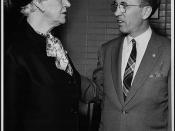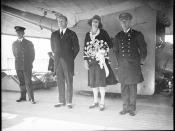"It was the best of times, it was the worst of times, it was the age of wisdom, it was the age of foolishness . . ."
Dickens begins "A Tale of Two Cities" with this famous sentence. It describes the spirit of the era in which this novel takes place. This era is the latter part of the 1700s - a time when relations between Britain and France were strained, America declared its independence, and the peasants of France began one of the bloodiest revolutions in history. In short, it was a time of liberation and a time of terrible violence. Dickens describes the two cities at the center of the novel: Paris, a city of extravagance, aristocratic abuses, and other evils that lead to revolution and London, a city rife with crime, capital punishment, and disorder. In both cities, the capabilities of an angry mob were a dangerous thing, to be feared by all.
In the Tale of Two Cities, by Charles Dickens, a woman is portrayed whose passion controls her. This woman, Therese Defarge, was so fervent towards vengeance that her own animosity dominated her and was her demise. Throughout the story, Madame Defarge let dark feelings of bitterness flow through her as she reached towards vindication, and while she did that, she was reflecting the actions of the aristocrats. Yet, she was immensely wary and cautious of her surroundings and always plotting. The actions of Madame Defarge were so hate provoked that she was blinded so she could not see or give compassion and in turn forgive. Therese Defarge was a truly distraught soul.
Foremost Madame Defarge was very scheming and vigilant; during the revolution, Mrs. Defarge masked her personal vendettas, towards the Evremondes, as fervent patriotism. "...But the wretched father was groveling...


